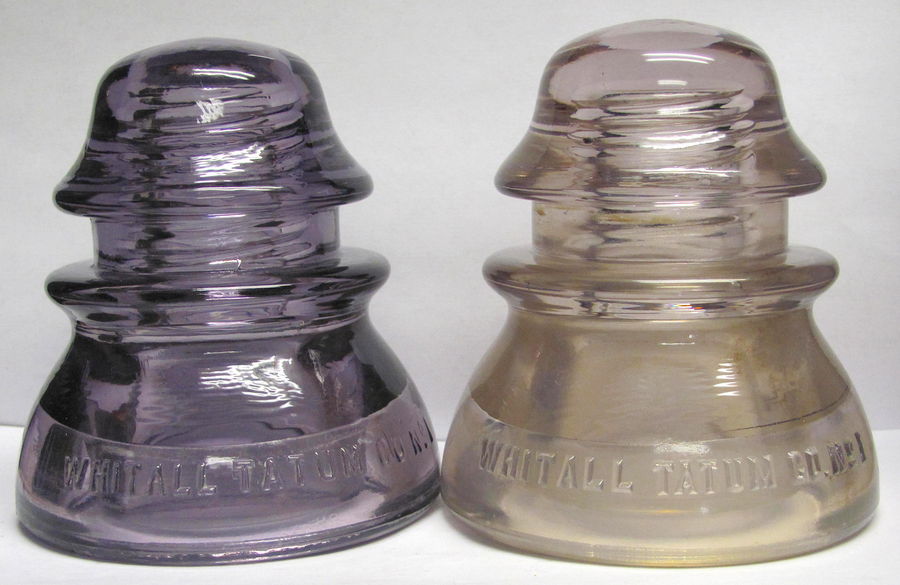
The following post shows the CD 154 Whitall Tatum No.1 which was used in large numbers on the Central of Georgia Railway telegraph lines. It came in a various colors including: shades of aqua blue to greenish; sun colored amethyst (SCA) (i.e. pink, lilac, purple etc.) and sun colored amber (i.e. peach, honey, amber). In this post, I will discuss glass chemistry using Whithall Tatum glass production as my model. Glass is a soda lime silicate which creates complex silicone networks once it goes from molten liquid to solid glass. In the manufacture of an insulator, the target is to maintain clear glass. If the glass is colored - and thus dark - spiders will build nest under the insulator and eventually reduce the electric insulation value. In some cases, such as the CD 162 HG Co. / Hemingray No. 19, colors are of value to mark certain special lines (i.e. cobalt, peacock, amethyst & amber). I believe that the earliest CD 154 Whitall Tatum No. 1 was in shades of aqua. In this case the color came from leaching metals from the mold and /or from the raw material used in glass manufacture. These metals included: iron, copper, chromium or nickel. Lead oxide impurities gave amber color and uranium oxide impurities gave a glowing /fluorescent yellow-green /citrine coloration in glass (i.e "uranium glass) [id=604186426]. For the highest quality glass insulator, various de-colorants were used to counter the impact of the mold / raw material impurities. These decolorants included: manganese, selenium, and cobalt. The question was always - does the cost of the raw materials justify the use of an expense de-colorant. In some glass insulator production like the CD 162 Madwell tin, antimony, and arsenic oxide were used to produce opaque white glass - i.e "milk glass". The chemistry of glass is more complex than one would think. All glass manufacture used a variation of the following formula: sand /silica (generally local quartz pebbles ground into a fine sand); soda ash (either sodium or potassium); local limestone (used for flux - calcium oxide & calcium carbonate); decolorant and sometimes cullet (i.g. local recycled bottles). The limestone flux is especially important to control "glass disease" - i.e. spalling, cracking, and fragmentation). It is also important to eliminate water from the composition because it changes pH and results in hydrogen generation - i.e. bubbles in the glass. The purple /amethyst CD 154 WT No. 1 used manganese oxide as the de-colorant and that was a big mistake. The insulator was clear on delivery, but the UV light from the sun reacted with components in the glass to turn the insulator color from clear to pink to sun colored amethyst. Whithall Tatum also attempted use of a selenium de-colorant, but UV light eventually resulted in a honey amber color. The pink color in the above picture was only found on a newer generation line (short section which ran from Fort Valley, GA West) that was installed in the 1970's or 1980's. This line was not there in 1972, but was present when I went back down to Georgia to hunt insulators with friends. The line with these CD 154 WT's in peach-pink also had Porter plastic and Continental rubber insulators. I speculate that the peach-pink color came from use of a manganese - selenium combination of de-colorants that resulted in color due to UV light activation. I also think this is a relatively uncommon CD 154 WT color. I also think that the use of a de-colorant was a waste of money as the train soot darkened the insulator fairly rapidly. In the case of the peach-pink color, the diesel trains were in operation and the heavy particulate soot was not a big issue. |